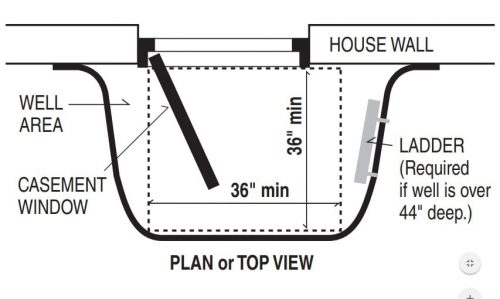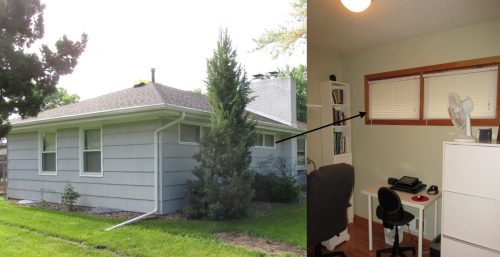There has to be a large group of home inspector trainers who tell home inspectors that every bedroom needs two methods of egress. I’ve heard this repeated by home inspectors in online discussions more times than I can count, and it’s based on nothing. This is a total myth. A bedroom needs one method of egress. More is fine, but not required.
While section R311 of the building code discusses Means of Egress at length, this section is all about people having a clear path to get out of a building, not about openings in bedrooms. If someone wanted to build a home and have no pathway from a bedroom to the rest of the home, they could. I’ve never seen this done and I can’t imagine anyone ever wanting to do this, but it would not be a code violation.
What is egress?
Egress is not defined in the building code. Usually, when people say egress they’re referring to the Emergency Escape and Rescue Opening. This term makes it clear that this required opening in the building isn’t just for getting out (egress). It’s also there to allow for emergency rescues. I’ve heard people call this “ingress”, but I refuse to use that word because it sounds made-up.
The building code definition for an Emergency Escape and Rescue Opening is “an operable exterior window, door or similar device that provides for a means of escape and access for rescue in the event of an emergency.” I think this term is already pretty self-explanatory, but I included the definition to make it clear that the opening doesn’t need to be a window. It just needs to be something big enough to get people in and out. A door would be just fine.
So now that I’ve covered the proper terminology for any online trolls/word sticklers, I’m going to go back to calling it egress. I prefer layman’s terms.
Egress requirements
If you’re in Minnesota, check out section R310 of the Minnesota State Building Code for all of the requirements. I’m not going to explain all of these requirements, but I’ll list the basics:
- Basements, habitable attics, and sleeping rooms need to have an egress opening
- The bottom of the required opening must be within 44″ of the floor.
- The width of the opening must be at least 20″.
- The height of the opening must be at least 24″.
- The net clear opening must be at least 5.7 square feet unless the bottom of the opening is within 44″ of the ground at the exterior. In those cases, the opening can be reduced to 5 square feet.
- Window wells must be at least 3′ x 3′, and they must allow the window to open fully. If the window well is more than 44″ deep, it needs a ladder.
- If there’s a deck or porch above the basement window well, at least 36″ of headroom is needed.
The City of Bloomington has a nice handout on Egress Requirements explaining these requirements. This handout also has some nice diagrams, which I’ve copied below.
Here are some exceptions that are special to Minnesota:
- If the home is fully protected by an automatic sprinkler system, no egress opening is required in basement bedrooms.
- Replacement windows are allowed to reduce the window opening to less than the requirements listed above. The replacement window basically needs to be the same type as the original, and it needs to be the largest window that will fit in the existing opening. I’ve heard many people refer to this allowance as the ‘Renewal by Andersen exception’.
What should a home inspector say about egress?
In my humble opinion, a home inspector doesn’t need to measure a window to decide if it’s safe or not. We can look at a window and decide whether or not most people could get out. In fact, most people can do this. I see no need for a home inspector to measure windows to justify recommendations for added safety.
If a window is small and someone would have a hard time getting out of the home, it’s obvious. A home inspector should call this a safety hazard and recommend correction of this condition, or recommend not using the room as a bedroom. There’s no need to measure the window to prove this; anyone can tell just by looking at it.
Update 7/11/18: the sizes listed above aren’t just about getting out of a building; they’re also about allowing a firefighter to get into the building while wearing a big air tank. I’m not as concerned about this part of the equation. If a building is on fire, a firefighter won’t worry about delicately unlocking a window and cranking it open; they’re going to knock the whole thing out of the frame.
The images below show a nice example of such a room. The seller of this home was using the room as an office, not a bedroom. Nevertheless, I added a comment in my report mentioning that the windows in the first-floor office were much too high for proper egress, and the room should not be used as a bedroom.




